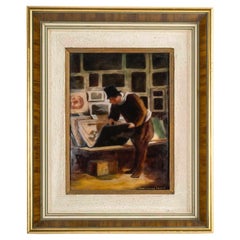Henriette Marty
Vintage 1930s French Belle Époque Decorative Art
Enamel
Camille Fauré for sale on 1stDibs
Camille Faurè produced designs for Limoges, long famed for its enamels.
Born in Perigueux, France, in 1874, Faurè spent a long apprenticeship before setting up his own workshop at Limoges, where he worked for over fifty years. Fauré became Limoges’ most famous and talented enamel artist. He exhibited in the 1925 International Exhibition of Modern Decorative and Industrial Arts, which gave Art Deco its name.
Faurè’s early work, like his post–World War II designs, involved large floral patterns, often in rich colors that kept in line with the Art Nouveau movement. He exhibited through his Paris shop, and produced vases, bowls, ashtrays, boxes and other items.
Faurè’s vases were made in many different shapes, including those of the gourd, kettledrum and egg, with geometric or stylized floral patterns. It was his geometric designs, however, which set him apart as the greatest creative enameller of the Art Deco style. These geometric designs included chevrons, lozenges, diagonal and stripe patterns and floral motifs, ranging from naturalistic to stylized patterns of leaves and flowers. The geometric patterns featured strong hues of blue, red, orange and yellow accented with blacks, whereas the floral patterns had more delicate hues such as turquoise, light blue, pink, lavender and white. Some vases had panels and borders of floral motifs combined with geometric stepped and angled motifs.
Using large vessels, vases, bowls or open-mouthed jardinières, the copper was covered in multiple layers of polychrome enamels in hard, vitreous, three-dimensional geometric designs of subtle complexity and color combinations. Faurè’s friend Marty occasionally worked with him in a very similar style. Both produced a small number of pendants in enameled gold, silver and copper.
Find a collection of Camille Faurè furniture and decorative objects on 1stDibs.
(Biography provided by Ophir Gallery)
Finding the Right Decorative-objects for You
Every time you move into a house or an apartment — or endeavor to refresh the home you’ve lived in for years — life for that space begins anew. The right home accent, be it the simple placement of a decorative bowl on a shelf or a ceramic vase for fresh flowers, can transform an area from drab to spectacular. But with so many materials and items to choose from, it’s easy to get lost in the process. The key to styling with antique and vintage decorative objects is to work toward making a happy home that best reflects your personal style.
Ceramics are a versatile addition to any home. If you’ve amassed an assortment of functional pottery over the years, think of your mugs and salad bowls as decorative objects, ideal for displaying in a glass cabinet. Vintage ceramic serveware can pop along white open shelving in your dining area, while large stoneware pitchers paired with woven baskets or quilts in an open cupboard can introduce a rustic farmhouse-style element to your den.
Translucent decorative boxes or bowls made of an acrylic plastic called Lucite — a game changer in furniture that’s easy to clean and lasts long — are modern accents that are neutral enough to dress up a coffee table or desktop without cluttering it. If you’re showcasing pieces from the past, a vintage jewelry box for displaying your treasures can spark conversation: Where is the jewelry box from? Is there a story behind it?
Abstract sculptures or an antique vessel for your home library can draw attention to your book collection and add narrative charm to the most appropriate of corners. There’s more than one way to style your bookcases, and decorative objects add a provocative dynamic. “I love magnifying glasses,” says Alex Assouline, global vice president of luxury publisher Assouline, of adding one’s cherished objects to a home library. “They are both useful and decorative. Objects really elevate libraries and can also make them more personal.”
To help with personalizing your space and truly making it your own, find an extraordinary collection of decorative objects on 1stDibs.
